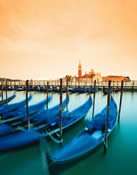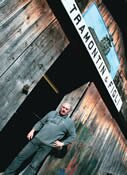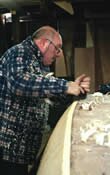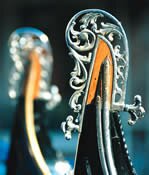Inflight Magazine of Brussels Airlines
Welcome to the Inflight Magazine of Brussels Airlines
Going, going, gondola
Venice and gondolas, the two go hand-in-hand, but while there may be plenty of these graceful craft cruising the canals, Scott Adams reveals that the art of making them is dying out fast
Fifty years ago, there were over 40 gondola workshops, while today that number has dwindled to only two. The good news is that the workshops that have survived are now busier than ever and the art of gondola making lives on…
 The gondola builder
The gondola builder
Roberto Tramontin, a fourth generation squerariolo (gondola builder) has his squero (gondola workshop) in a quiet area behind the famed Accademia art gallery, just off the Grand Canal. It’s still a hive of activity today, as it has been for over 125 years.
“I started working with my father when I was a young boy and have spent all my life with gondolas,” says the tanned Venetian, with a smile. “One hundred years ago there were dozens of workshops and everyone was competing for work. Today, we are lucky to still be busy making or repairing gondolas.”
When asked about the length of time that it takes to make these emblematic craft, Roberto rubs his calloused hands together thoughtfully as he looks around at the piles of different types of wood and the gondolas in various stages of completion in his squero. ‘We only make a maximum of three a year because the process is so complicated,” he confesses. “Between stages, you have to wait for the wood to shrink and condition. We start on one gondola and then we leave it for a few months while we work on another.”
 Through the generations
Through the generations
Building methods have hardly changed since Roberto was a boy, helping his father, Roberto senior. In fact, little has altered since gondolas first appeared on the lagoon some 900 years ago. To aid the builder, there are neither textbooks nor formal blueprints, just a cluster of large century-old cut-outs, like parts of an oversized jigsaw. These are the equivalent of pieces of a sewing pattern, from which the wood is cut to shape. The other essential know-how is committed to memory: nothing is written down but passed on from generation to generation.
Each of the eight different types of wood used in the construction is chosen for its particular characteristics, especially how it will react with the design and the water. The planks are stored by type and are left in the shed for over a year, as part of the maturing process. Their condition is monitored by the expert eye and touch of Roberto who, after years in the business, can tell what stage the wood is at.
 Oak, elm, fir and walnut are the principal woods used for the body, while cherry, lime, mahogany and rosewood are used in the decoration. “Fir is used in the bottom and the ribs of the gondola, while oak is best suited to the sides,” Roberto explains, while eyeing carefully an apprentice painting a half-finished gondola.
Oak, elm, fir and walnut are the principal woods used for the body, while cherry, lime, mahogany and rosewood are used in the decoration. “Fir is used in the bottom and the ribs of the gondola, while oak is best suited to the sides,” Roberto explains, while eyeing carefully an apprentice painting a half-finished gondola.
In all, there are 280 pieces of wood in the construction. The only elements of metal are the decorative pieces at the stern and the bow. All the wooden joins are achieved without nails and are waterproofed by heating the timber over a low-temperature fire, fuelled by lagoon reeds.
Custom-made craft
The history of the Tramontin squero dates back to 1884 when the yard was established by Domenico Tramontin, who had learnt his craft in one of the other boatyards in Venice. He decided to start his own business making gondolas with a slight change in the design. The hull was made slightly wider at the stern to compensate for the noteworthy increase in weight of the gondoliers of the time. He also raised the bow to increase the elegance of the line in the water.
 “These changes in design were so favourably received by the gondoliers that soon all the builders were adopting them,” Roberto comments, while looking at the framed photo on the wall of his distinguished ancestor. “In fact, I can proudly say that it was my great-grandfather who was responsible for the shape of the gondolas we see today,”
“These changes in design were so favourably received by the gondoliers that soon all the builders were adopting them,” Roberto comments, while looking at the framed photo on the wall of his distinguished ancestor. “In fact, I can proudly say that it was my great-grandfather who was responsible for the shape of the gondolas we see today,”
A gondola is not just a boat made to the same standard design each time. In fact, when a new one is ordered by its eventual stripe-shirted owner, it is custom-built to be used only by him. Today, the most important factor to consider is the weight of the gondolier. Gondolas are not symmetrical but are slightly twisted. The left side is 24cm longer than the right. This difference means that it always navigates to one side, and the position of the gondolier and his weight compensates for this.
When asked about the future of the gondola workshops, Roberto is not all optimism. “Today, young people don’t really find this work interesting,” he confides. “It is in some ways tedious and difficult and, as an apprentice, you have to learn a great deal over many long years.”
The risk is not that the straw-hatted gondoliers will be without vessels to row, or that millions of tourists who flock to Venice every year will be denied the ultimate romantic experience. It is rather that future gondolas may be made outside Italy by cheap labour with no regard for the traditions and history of one of the world’s most fascinating cities.
Thank goodness that, with the help of Roberto Tramontin and his workshop, the quality of the workmanship is still high, and hopefully will stay that way.
FR Glissent, glissent les gondoles
Venise et les gondoles : les deux ne vont pas l’un sans l’autre. Mais si ces gracieuses embarcations sont nombreuses à naviguer sur les eaux du canal, Scott Adams nous révèle que l’art de leur fabrication est en train de s’éteindre à petit feu
Roberto Tramontin, un squerariolo de la quatrième génération (constructeur de gondoles) possède un squero (atelier de gondoles) dans un quartier calme derrière la célèbre galerie d’art de l’Accademia, le long du Grand Canal. Depuis 125 ans, l’activité y est toujours aussi bourdonnante.
« J’ai commencé à travailler avec mon père lorsque j’étais petit garçon et j’ai passé toute ma vie avec les gondoles, » dit le Vénitien au teint bronzé, arborant un sourire. « Il y a cent ans d’ici, il y avait des douzaines d’ateliers, tous en compétition pour avoir du travail. Mais aujourd’hui, nous avons la chance d’être toujours en activité dans la construction ou la réparation des gondoles » continue Roberto, expliquant que le processus est tellement compliqué qu’il ne fabrique que trois gondoles par année.
Chaque embarcation est faite sur mesure, réservée exclusivement au gondolier qui l’a commandée. Ces esquifs ne sont pas symétriques mais légèrement distordus, avec un côté gauche plus long que le côté droit. Cette différence signifie que les gondoles naviguent toujours d’un même côté, et la position ainsi que le poids du gondolier compensent la différence.
Le savoir-faire d’un squerariolo fait partie de la mémoire patrimoniale : rien n’est écrit et il n’existe aucuns plans de construction. Un apprenti doit donc pouvoir passer des années pour acquérir les compétences nécessaires, basées sur une connaissance transmise de génération en génération rassemblant des données séculaires comme les pièces d’un immense puzzle. Mais fort heureusement, la réduction drastique du nombre d’ateliers de construction n’empiète pas sur la qualité du métier qui reste toujours très élevée. Et avec la présence de Roberto Tramontin et de sa fabrique, le statut de la profession peut espérer perdurer.
NL Ga, ga, gondel
Venetië en gondels, de twee horen bij elkaar, maar terwijl er genoeg van deze sierlijke vaartuigen op de kanalen dobberen, onthult Scott Adams dat de kunst van het vervaardigen ervan snel aan het uitsterven is
Roberto Tramontin, een squerariolo (gondelbouwer) van de vierde generatie heeft zijn squero (gondelatelier) in een rustige zone achter de befaamde Accademia kunstgalerij, niet ver van het Canal Grande. Het is nog steeds een bedrijvigheid van jewelste, en dit al 125 jaar lang.
“Ik begon als jongeman bij mijn vader te werken en ik heb al heel mijn leven met gondels te maken,” zegt de gebruinde Venetiaan lachend. “Honderd jaar geleden waren er dozijnen ateliers en iedereen beconcurreerde elkaar voor werk. Maar nu mogen we van geluk spreken dat we werk hebben met het maken of herstellen van gondels,” gaat Roberto verder en hij legt uit dat hij slechts 3 gondels per jaar maakt omdat het vervaardigen ervan zo ingewikkeld is.
Elke gondel wordt op bestelling gemaakt om enkel door de gondelier te worden gebruikt die hem heeft besteld. De vaartuigen zijn niet symmetrisch, maar licht gedraaid waarbij de linkerkant iets langer is dan de rechterkant. Dit verschil betekent dat de gondel altijd naar één kant vaart, maar dit wordt gecompenseerd door de positie en het gewicht van de gondelier.
De knowhow van een squerariolo zit enkel in het geheugen: er wordt niets opgeschreven en er zijn geen officiële blauwdrukken. Een leerling moet dus jarenlang de nodige vaardigheden aanleren, gebaseerd op kennis die van generatie op generatie werd doorgegeven, plus een heleboel eeuwenoude uitsnijdingen, waardoor het allemaal een beetje een grote puzzel lijkt.
Godzijdank dat, hoewel het aantal gondelateliers dramatisch is gedaald, de kwaliteit van het ambacht nog steeds hoog is. En met de hulp van Roberto Tramontin en zijn atelier zal dit zo blijven.
Leave a Reply
